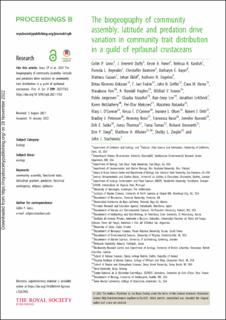The biogeography of community assembly : latitude and predation drive variation in community trait distribution in a guild of epifaunal crustaceans
| dc.contributor.author | Gross, Colin P. | |
| dc.contributor.author | Duffy, Emmett | |
| dc.contributor.author | Hovel, Kevin A | |
| dc.contributor.author | Kardish, Melissa R | |
| dc.contributor.author | Reynolds, Pamela L. | |
| dc.contributor.author | Boström, Christoffer | |
| dc.contributor.author | Boyer, Katharyn | |
| dc.contributor.author | Cusson, Mathieu | |
| dc.contributor.author | Eklöf, Johan | |
| dc.contributor.author | Engelen, Aschwin H. | |
| dc.contributor.author | Eriksson, Britas Klemens | |
| dc.contributor.author | Fodrie, F. Joel | |
| dc.contributor.author | Griffin, John N. | |
| dc.contributor.author | Hereu, Clara M. | |
| dc.contributor.author | Hori, Masakazu | |
| dc.contributor.author | Hughes, A. Randall | |
| dc.contributor.author | Ivanov, Mikhail V. | |
| dc.contributor.author | Jorgensen, Pablo | |
| dc.contributor.author | Kruschel, Claudia | |
| dc.contributor.author | Lee, Kun-Seop | |
| dc.contributor.author | Lefcheck, Jonathan | |
| dc.contributor.author | McGlathery, Karen | |
| dc.contributor.author | Moksnes, Per-Olav | |
| dc.contributor.author | Nakaoka, Masahiro | |
| dc.contributor.author | O'Connor, Mary I. | |
| dc.contributor.author | O'Connor, Nessa E | |
| dc.contributor.author | Olsen, Jeanine L. | |
| dc.contributor.author | Orth, Robert J | |
| dc.contributor.author | Peterson, Bradley J. | |
| dc.contributor.author | Reiss, Henning | |
| dc.contributor.author | Rossi, Francesca | |
| dc.contributor.author | Ruesink, Jennifer | |
| dc.contributor.author | Sotka, Erik E. | |
| dc.contributor.author | Thormar, Jonas | |
| dc.contributor.author | Tomas, Fiona | |
| dc.contributor.author | Unsworth, Richard | |
| dc.contributor.author | Voigt, Erin P | |
| dc.contributor.author | Whalen, Matthew A. | |
| dc.contributor.author | Ziegler, Shelby L | |
| dc.contributor.author | Stachowicz, John J. | |
| dc.date.accessioned | 2022-11-29T12:35:40Z | |
| dc.date.available | 2022-11-29T12:35:40Z | |
| dc.date.created | 2022-02-24T11:00:06Z | |
| dc.date.issued | 2022 | |
| dc.identifier.citation | Gross, C. P., Duffy, E., Hovel, K. A., Kardish, M. R., Reynolds, P. L., Boström, C., Boyer, K., Cusson, M., Eklöf, J., Engelen, A. H., Eriksson, B. K., Fodrie, F. J., Griffin, J. N., Hereu, C. M., Hori, M., Hughes, A. R., Ivanov, M. V., Jorgensen, P., Kruschel, C., Lee, K., Lefcheck, J., McGlathery, K., Moksnes, P., Nakaoka, M., O'Connor, M. I., O'Connor, N. E., Olsen, J. L., Orth, R. J., Peterson, B. J., Reiss, H., Rossi, F., Ruesink, J., Sotka, E. E., Thormar, J., Tomas, F., Unsworth, R., Voigt, E. P., Whalen, M. A., Ziegler, S. L. & Stachowicz, J. J. (2022). The biogeography of community assembly: latitude and predation drive variation in community trait distribution in a guild of epifaunal crustaceans. Proceedings of the Royal Society of London. Biological Sciences, 289(1969). doi: | en_US |
| dc.identifier.issn | 1471-2954 | |
| dc.identifier.uri | https://hdl.handle.net/11250/3034747 | |
| dc.description.abstract | While considerable evidence exists of biogeographic patterns in the intensity of species interactions, the influence of these patterns on variation in community structure is less clear. Studying how the distributions of traits in communities vary along global gradients can inform how variation in interactions and other factors contribute to the process of community assembly. Using a model selection approach on measures of trait dispersion in crustaceans associated with eelgrass (Zostera marina) spanning 30° of latitude in two oceans, we found that dispersion strongly increased with increasing predation and decreasing latitude. Ocean and epiphyte load appeared as secondary predictors; Pacific communities were more overdispersed while Atlantic communities were more clustered, and increasing epiphytes were associated with increased clustering. By examining how species interactions and environmental filters influence community structure across biogeographic regions, we demonstrate how both latitudinal variation in species interactions and historical contingency shape these responses. Community trait distributions have implications for ecosystem stability and functioning, and integrating large-scale observations of environmental filters, species interactions and traits can help us predict how communities may respond to environmental change. | en_US |
| dc.language.iso | eng | en_US |
| dc.title | The biogeography of community assembly : latitude and predation drive variation in community trait distribution in a guild of epifaunal crustaceans | en_US |
| dc.title.alternative | The biogeography of community assembly: latitude and predation drive variation in community trait distribution in a guild of epifaunal crustaceans | en_US |
| dc.type | Peer reviewed | en_US |
| dc.type | Journal article | en_US |
| dc.description.version | publishedVersion | en_US |
| dc.rights.holder | © 2022 The Author(s) | en_US |
| dc.subject.nsi | VDP::Matematikk og Naturvitenskap: 400::Zoologiske og botaniske fag: 480::Marinbiologi: 497 | en_US |
| dc.subject.nsi | VDP::Matematikk og Naturvitenskap: 400::Zoologiske og botaniske fag: 480::Økologi: 488 | en_US |
| dc.subject.nsi | VDP::Matematikk og Naturvitenskap: 400::Zoologiske og botaniske fag: 480::Zoogeografi: 486 | en_US |
| dc.source.pagenumber | 10 | en_US |
| dc.source.volume | 289 | en_US |
| dc.source.journal | Proceedings of the Royal Society of London. Biological Sciences | en_US |
| dc.source.issue | 1969 | en_US |
| dc.identifier.doi | 10.1098/rspb.2021.1762 | |
| dc.identifier.cristin | 2005085 | |
| dc.relation.project | National Science Foundation: NSF-OCE 1336206 | en_US |
| dc.relation.project | National Science Foundation: OCE 1336905 | en_US |
| dc.relation.project | National Science Foundation: OCE 1336741 | en_US |
